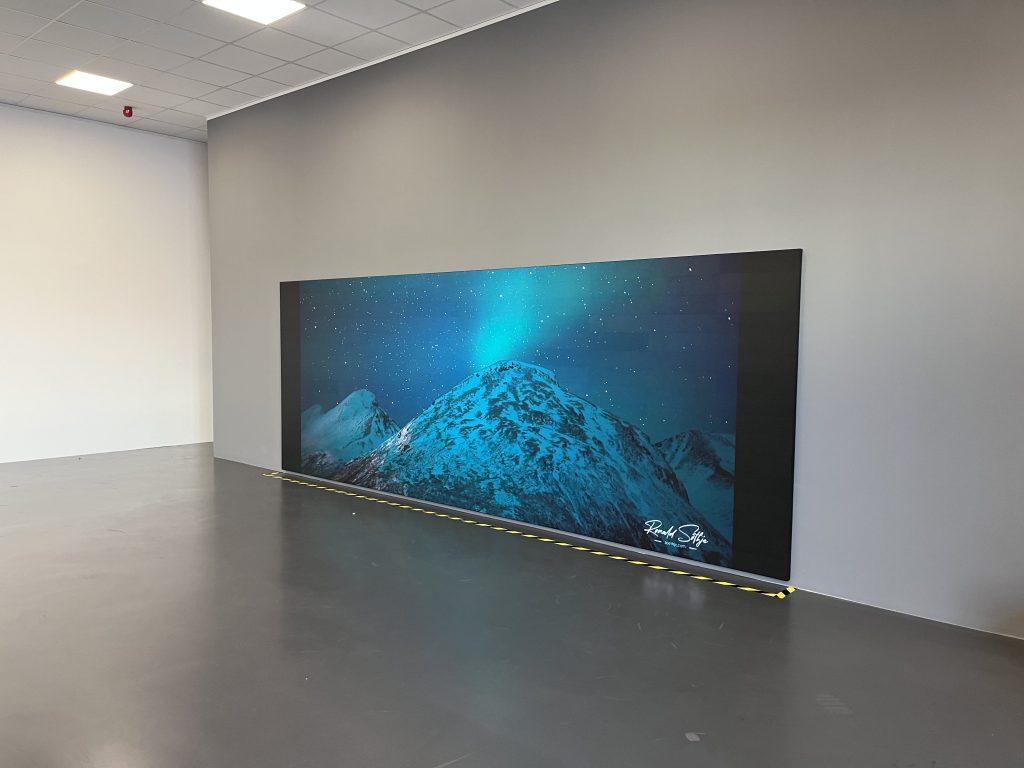Posted May 26th, 2023 by Emily Burkinshaw & filed under , Case Study, Newsletters, Technology.
Pro Display recently supplied an indoor LED video-wall for state-of-the-art concept car visualisation. The screen dimensions are 5.5m x 2m x 0.04m (217 x 79 x 1.6 inches), weighing 238kg and it is composed of 44 square modules fitting together like a jigsaw, 11 modules horizontally and 4 modules vertically. Each module measures 500mm x 500mm with 256 x 256 pixels and a pixel pitch of 1.9mm and is composed of 4 replaceable 500mm x 125mm LED panels.
The screen has 2816 LEDs horizontally and 1024 LEDs vertically, totalling almost 3 million LEDs (pixels) with a brightness of up to 1000nits. The horizontal and vertical viewing angle is 160 degrees, leaving just 10 degrees on each side unviewable. It has an average power consumption of 7kW, requires 4 power sockets and has grounding and overload protection. Receiving cards, LED controllers and spare parts are included.
Pro Display’s indoor LED screens are manufactured using the highest quality LED components, offering stunning brightness, contrast and colour reproduction. Available in a range of pixel pitches from 0.9mm to 10mm, our Indoor LED displays provide a level of brightness and vibrancy that standard LCD displays cannot compete with.

Large-format modular LED displays are screens that use light-emitting diodes (LEDs) to create high-definition images and videos. They are composed of smaller modules that can be connected together to form larger screens of various sizes and shapes. They are often used for commercial, entertainment and educational purposes, such as advertising, digital signage, presentations and interactive learning.
What are the benefits of large-format modular LED displays?
Large-format modular LED displays have several advantages over traditional LCD or projection screens, such as:
- Higher brightness and contrast: LEDs can produce more vivid colours and deeper blacks than LCDs or projectors, making them suitable for outdoor and indoor environments with high ambient light.
- Lower power consumption and heat generation: LEDs are more energy-efficient and generate less heat than LCDs or projectors, reducing the need for cooling systems and saving on electricity costs.
- Longer lifespan and durability: LEDs can last up to 100,000 hours or more, while LCDs or projectors have a shorter lifespan and are more prone to damage from dust, moisture and impact.
- Greater flexibility and scalability: Modules can be arranged in different configurations and shapes to fit any space and design requirement. They can also be easily added or removed to adjust the screen size and resolution as needed.
- Better viewing angle and uniformity: LEDs have a wider viewing angle and more consistent brightness and colour across the screen than LCDs or projectors, enhancing the visual experience for the audience.
How do large-format modular LED displays work?
Large-format modular LED displays work by using an array of tiny LEDs to create pixels that form images and videos. Each module contains a circuit board with rows and columns of LEDs, along with a driver that controls the brightness and colour of each LED. The modules are connected to each other by cables or wireless signals, forming a larger screen that can display content from various sources, such as computers, media players, cameras or cloud services.
The resolution of a large-format modular LED display depends on the number and size of the modules, as well as the pixel pitch of each module. The pixel pitch is the distance between the center of two adjacent LEDs, measured in millimetres. The smaller the pixel pitch, the higher the resolution and the sharper the image quality. However, the smaller the pixel pitch, the more modules and LEDs are required, which increases the cost and complexity of the screen.
How to connect large-format modular LED displays?
Large-format modular LED displays can be connected to various devices and sources using different methods, such as:
- HDMI: A standard interface that transmits high-definition audio and video signals between devices. It supports resolutions up to 4K at 60 Hz or 8K at 30 Hz.
- USB: A universal interface that transfers data and power between devices. It can also support audio and video signals using adapters or converters. It supports resolutions up to 4K at 60 Hz.
- DisplayPort: An alternative interface that transmits high-definition audio and video signals between devices. It supports resolutions up to 8K at 60 Hz or 4K at 120 Hz.
- Wi-Fi: A wireless network that allows devices to communicate with each other over radio waves. It can also stream audio and video signals using protocols such as Miracast or AirPlay. It supports resolutions up to 4K at 30 Hz.
- Ethernet: A wired network that connects devices using cables. It can also transmit audio and video signals using protocols such as HDBaseT or IP. It supports resolutions up to 4K at 60 Hz.